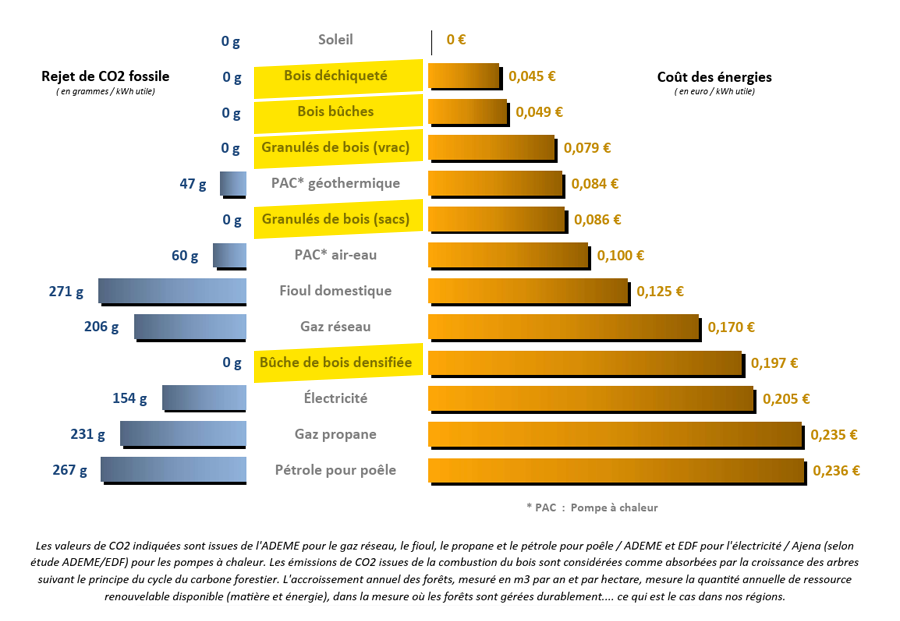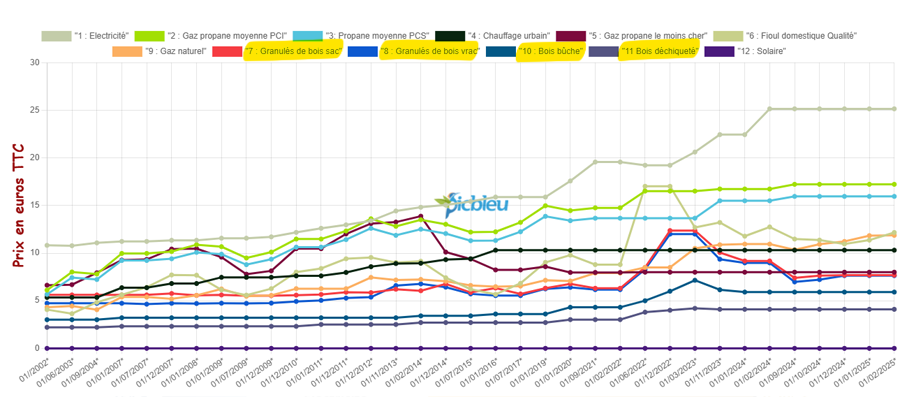Wood heating protects your purchasing power
To protect your purchasing power, you can always count on wood heating.

In the form of logs or pellets, wood is the most competitive energy source on the market (more than 3 times cheaper than electricity*). It is also a particularly stable energy source because it is not dependent on fluctuations in other energy sources. In short, wood energy is a safe bet.
Wood heating, still the most competitive heating method
In log form, bagged or bulk, wood energy consistently ranks among the most competitive fuels on the market. And it has been for many years. Nearly 8 million French households are aware of this and use it to, among other things, reduce their energy bills.
According to the energy Argus published by the Ajena association (February 2025):

The most stable energy source in years
Wood heating is also known for its price stability. Unlike fossil fuels or electricity, whose prices can fluctuate based on international markets and geopolitical crises, the price of wood remains relatively stable year after year. No spectacular increase, no bad surprise, this stability is a major asset for consumers looking to control their energy budget.
The evolution of the prices of the main energies published by Picbleu (January 2025):

Why wood energy sustainably protects household budgets
- Because unlike fossil fuels, wood is a renewable, abundant, and locally available resource. No need to import, no risk of shortages...Equipping yourself with a wood heating appliance is a sustainable investment.
- Because wood energy can be obtained year-round and easily stored, which allows households to plan and smooth out their energy costs. Wood energy allows them to avoid seasonality, even if price variations are relatively small between low-demand seasons (spring and summer) and high-demand seasons (autumn and winter). In any case, wood energy allows them to anticipate their purchases, which is a unique advantage of this energy source.
- Because using wood as fuel helps promote local resources and support the local economy. This contributes to job creation and regional economic development. Promoting local resources strengthens purchasing power by promoting short supply chains and reducing fuel transportation costs. It's a virtuous circle that benefits everyone.
- Because appliances are becoming more and more efficient and consume less and less fuel. In other words, the energy efficiency obtained with the same quantity of wood fuel is higher today than yesterday and lower than tomorrow.
The further we go in time, the less wood we will need to consume to achieve the same thermal comfort. To illustrate this reduction, here is a projection of the evolution of log wood consumption and the number of log wood-burning appliances by 2035:

Here is a projection of the evolution of wood pellet consumption and the number of pellet appliances by 2035: 
Sources: Estimate by the Poujoulat Group / Summary of the SER note on biomass availability.
- - Some energy sources more affected by the effects of the crises have been able to benefit from price shields, measures put in place by the government to protect French consumers from the sharp rise in energy prices. Not wood energy.
- The price of wood energy found in stores is its "real market price," without a shield. There is therefore no risk of its price skyrocketing when the various protective measures are removed...
This is why wood heating is also a shield for consumers.
*Source: Ajena (wood logs: €0.049/kWh, bulk wood pellets: €0.079/kWh, electricity: €0.205/kWh) (Feb. 2025)











